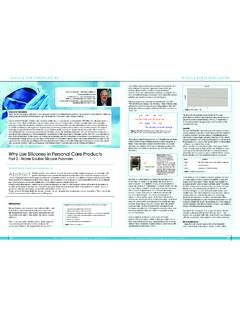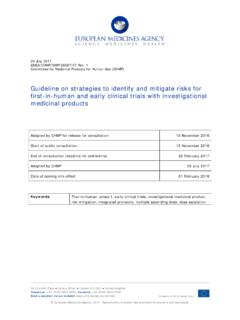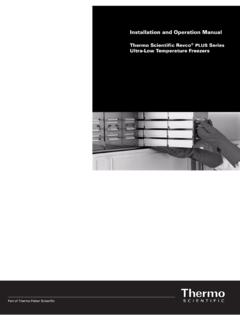Transcription of The HLB SYSTEM - Scientific Spectator
1 1 TheHLB SYSTEM atime-savingguidetoemulsifierselectioned ited and reprinted from CHEMMUNIQUE,publication of ICI Americas Americas , Delaware 19897 ANTICIPATING NEEDS2 TWEEN 20 SPAN 20 TWEEN 40 TWEEN 80 TWEEN 60 TWEEN 21 TWEEN85 TWEEN 65 TWEEN 81 TWEEN 61 SPAN 40 SPAN 60 SPAN 65 SPAN 85 SPAN80 HLB scale of typicalATLAS emulsifiers20100hydrophiliclipophilicCHA PTER 1 Meaning of HLBA dvantages and LimitationsTrademarks of ICI Americas Inc., include:ARLACEL, ARLASOLVE, ARLATONE, ATLAS,ATLOX, ATMOS, ATMUL, BRIJ, MYRJ, RENEX,SPAN, TWEEN, TWEEN-MOS 1976 ICI Americas Inc. (All Rights Reserved)Revised, March, 19803 WHEN you are faced with the problem of makingan emulsion, you have your choice of hundredsupon hundreds of emulsifying agents - well over ahundred just from ICI alone. Out of this welter ofproducts, you have the unenviable task of selectingone or two which will satisfactorily emulsify yourchosen ingredients. You can choose from amonghundreds of manufacturers and thousands ofsurface active agents, according to the 1975 editionof John W.
2 McCutcheon's "Detergents andEmulsifiers"Your own definition of the words "satisfactorilyemulsify," as used above, is of course the primefactor in your choice of one emulsifier instead the HLB SYSTEM DoesTo help save time in emulsifier selection, ICIintroduced in the late 1940's a systematic scheme ofcentering down on the relatively few emulsifierssuitable for any given application. This is called theHLB SYSTEM - the letters HLB standing for"Hydrophile-Lipophile , the HLB SYSTEM enables you to assign anumber to the ingredient or combination ofingredients you want to emulsify, and then tochoose an emulsifier or blend of emulsifiers havingthis same least, this is the principle of the SYSTEM . Inpractice, unfortunately, the task is never the HLB SYSTEM does provide a useful guide -a series of beacons to steer you through channelswhere virtually no other markers the HLB SYSTEM Can Help MostOur discussion here will assume that you havehad some experience in making emulsions.
3 Acomplete dissertation on the many factors whichinfluence your choice of emulsifiers wouldnecessarily cover aspects of emulsion technologyfar beyond the HLB example, before you can begin making useof the HLB SYSTEM , you must set up some sort ofevaluation SYSTEM for your "satisfactory" you want an oil-in-water (O/W) emulsion or awater-in-oil (W/O)? How stable do you want youremulsion, in storage? -in use? What are your costlimits? Should your emulsifier be stable towardalkalies, salts, or electrolytes? Must it be non-toxic-or non-irritating to the skin? How about yourmanufacturing equipment -or the equipment yourcustomer might use in applying your emulsionproduct-will ease of preparation or applicationaffect your choice of emulsifier?Such factors as this may immediately lead you todiscard certain types or groups of emulsifiers fromfurther consideration. In any case, they willcertainly influence your choice of emulsifiers whenyou are weighing the relative merits of oneemulsion or another in final Numbers of Emulsifiers -What Do They Mean?
4 In the HLB SYSTEM , each emulsifier is assigned anumerical value which we call its HLB. The HLBof ICI emulsifiers is shown in all current ICIemulsifier literature, and similar values may becalculated or estimated by various means for anyemulsifier. Methods for determining this HLBvalue are discussed in Chapter HLB of an emulsifier is an expression of itsHydrophile-Lipophile Balance, the balance ofthe size and strength of the hydrophilic(water-loving or polar) and the lipophilic (oil-loving or non-polar) groups of the emulsifier. Allemulsifiers consist of a molecule that combinesboth hydrophilic and lipophilic emulsifier that is lipophilic in character isassigned a low HLB number (below ), and onethat is hydrophilic is assigned a high HLB number(above ). Those in the range of 9-11 two or more emulsifiers are blended, theresulting HLB of the blend is easily calculated.
5 Forexample, suppose you want to determine the HLBvalue of a blend comprising 70% of TWEEN 80(HLB = 15) and 30% Of SPAN 80 (HLB = 4-3).The calculation would be:TWEEN 80 70% X = 80 30% X = of blend = you will discover in applying the HLBS ystem, the HLB of an emulsifier or blend ofemulsifiers is an excellent indication of what theemulsifier SYSTEM will do, that is, whether it willmake an oil-in-water (O/W) emulsion or a W/Oemulsion, or act as a solubilizer for some oil. TheHLB of an emulsifier class or blend is also an4indication of the efficiency of chemically-relatedemulsifiers or of a blended pair of emulsifiers forperforming any given emulsifier you consider a variety of chemical typesof emulsifier, and classify them according to struc-ture, each class covers a segment of the HLB efficiency of these classes differs. HLB is notan indication of the relative efficiency of one classto another.
6 This "class efficiency" seems to berelated more to chemical structure (that is, whetherthe emulsifier is a soap, a partial ester, a completeester, whether the lipophilic group is saturated, etc.)and the relationship of its chemical structure to thechemical structure of the material to be chapters in this book will give yousome guides to comparison of chemical types whenthe "ideal" HLB of emulsifier for your applicationhas been determined, although no specific ruleshave been established for this step in Related to SolubilityThe HLB of an emulsifier is related to itssolubility. Thus, an emulsifier having a low HLBwill tend to be oil-soluble, and one having a highHLB will tend to be water-soluble, although twoemulsifiers may have the same HLB and yet exhibitquite different solubility who works with emulsifiers soonbecomes aware of the relationship between thesolubility of an emulsifier and its behavior.
7 Forexample, you will use a "water-soluble" emulsifieror blend to make an O/W emulsion, or to solubilizeoils, or to obtain detergent action. In other words,you use a "water-soluble" emulsifier when youwant your final product to exhibit aqueouscharacteristics, to dilute readily with water. Forthese purposes, you would rarely use an"oil-soluble" emulsifying SYSTEM . On the otherhand, if you wanted to make a W/O emulsion, orcouple watersoluble materials into an oil, orproduce some other type of non-aqueous emulsionsystem, you would choose an experience, then, you would expect that thefunctions of emulsifiers might well be classified byHLB, and this is true. Table I shows someinteresting general 1 HLB RangeUse4-6W/O emulsifiers7-9 Wetting agents8-18O/W emulsifiers13-15 Detergents10-18 SolubilizersThese correlations are based on long experiencewith ICI emulsifiers, and are amazingly accurate,although certain exceptions have been found.
8 Forexample, a few excellent detergents have beenfound in the HLB range oil-loving groups in surfactant are predominant, HLB is for producing water-in-oil water-loving groups predominate, the surfactant has high HLB and is used for oil-in-water oil-loving and water-loving groups are fairly well balanced, HLB is intermediate (around 10).5 CHAPTER 2"Required HLB" for Typical Ingredients to be EmulsifiedThe "Required HLB" of an IngredientThrough long experience in using the HLBS ystem, ICI emulsion technologists have found thatall oils, waxes and other materials likely to beincorporated into emulsions have an individual"Required HLB." For instance, in Table 2A, youwill see that the required HLB for a fluid O/W,emulsion of paraffin is means that an emulsifier, or blend ofemulsifiers, having an HLB of 10 will make a morestable fluid O/W paraffin emulsion than emulsifiersof any other HLB value.
9 It does not mean thatevery emulsifier or blend having an HLB of 10 will"work" - you might have an "HLB 10" emulsifier ofthe "wrong" chemical family (wrong for thispurpose, at least). However, you can be assured thatwhen you're working with any certain family ofemulsifiers, you will obtain optimum results morequickly if you work in the area of HLB 10, say 'd be wasting time to try emulsifier blends atHLB 8 or 13, for example, unless you mighthappen to be looking for a particular quality otherthan stability in your not make the mistake of assuming, from thispreliminary working data, that you shouldimmediately try all single emulsifiers in the catalogthat have an HLB of 10 for your paraffin , you can blend emulsifiers to make anyHLB you want, and blends usually work best. InChapters 5 and 6, emulsifier blends and selection of"chemical families" for trial will be discussed is important to remember that, as noted inTable 2 this HLB of 10 is for a 10-20% paraffinwax fluid O/W emulsion made by propeller you want an emulsion of different concentration,composition or viscosity-or made by a differentmethod-its required HLB will likely be in supplies and batches of oils andwaxes can also result in variations in required HLB for Ingredient BlendsTable 2 gives you some idea of the required HLBvalues for O/W emulsions of various oils andwaxes that you are likely to encounter mostfrequently.
10 From these values, you can calculaterequired HLB values for blends of these oils andwaxes, each component contributing its share to example, suppose you are making an O/Wemulsion textile lubricant. The product might be30% mineral spirits, 50% cottonseed oil and 20%chlorinated paraffin to be emulsified in water. Therequired HLB of the combination can be calculatedas follows:Mineral Spirits ..30% X Req. HLB 14 = Oil ..50% X Req. HLB 6 = Paraffin .. 20% X Req. HLB 14 = _____Estimated HLB for emulsifier SYSTEM .. should ckeck this estimated value with a fewexploratory tests in the range of say 9-11, as shownin Chapter 3, but you know from this calculation6 Method of Determining Above Required HLB ValuesThe figures in Table 2A, which supersede similarvalues published by ICI in other literature, represent theRequired HLB for O/W emulsions containing 20% (orless) of the material to be most cases, to 5% of several emulsifier blendswas tried, blended to HLB values 2 units apart in therange from 4 to 18.








